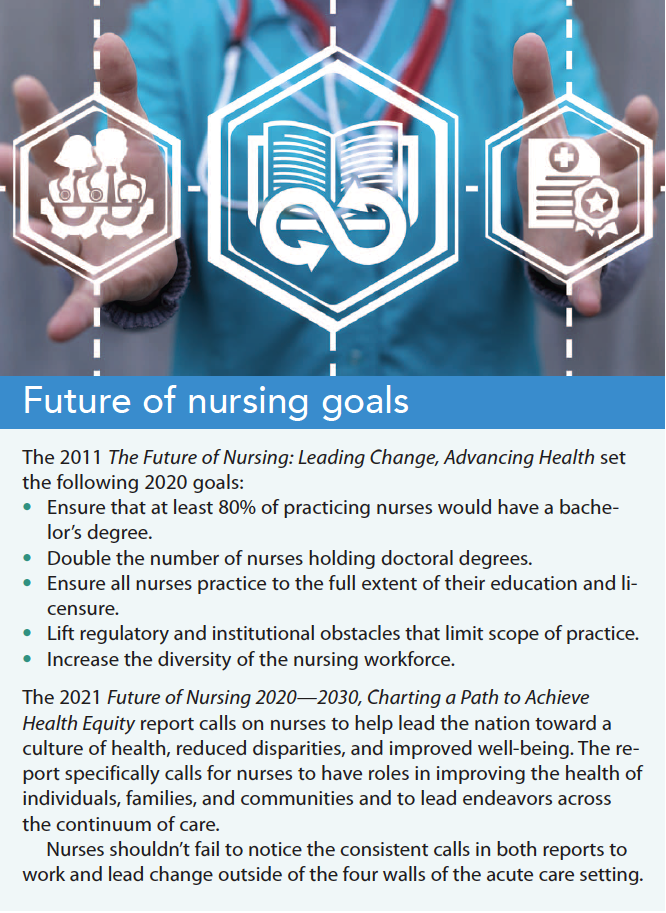Look to the past to prepare for the future.
- An urgent need exists for nurses to engage in and lead population health activities and services.
- Many familiar with the nurse role in acute care view the nurses engaged in population health activities as novel, but nursing has a long history of involvement in this aspect of healthcare.
- Nurses with competency to engage in and lead population health programs can help design and implement activities to improve a community’s overall health.
Significant change continues within healthcare and the nursing profession. To decrease health disparities and the costs of treatment and care, focus has turned toward prevention and population health and away from episodic acute care. This emphasis will require nurses to take on important operational and leadership roles in programs established to improve the health of the nation. These roles include identifying and mitigating social, environmental, and behavioral risk factors; assessing needs; and ensuring equitable healthcare for all. In addition to having strong population health knowledge and skills, nurses must also demonstrate confidence working autonomously, collaboratively, and innovatively as they lead in promoting community and population health. In addition, nurses will need to create new services and organizations that reduce disparities in targeted populations. Some in the nursing profession see this focus as new, but population health isn’t new to nursing. It’s core to what nurses have been doing for centuries.
A call to action
In 2010, President Barack Obama signed the Affordable Care Act (ACA) with a goal of reducing the number of uninsured individuals, decreasing the cost of healthcare, and improving care quality. The ACA spurred the development of expanded or new healthcare arrangements. Some of the innovative care models that have emerged or grown include accountable care organizations, patient medical homes, community health centers, and nurse-managed clinics, requiring nurses’ full participation and engagement.
In 2011, in response to the changes in healthcare, the Institute of Medicine (now the National Academy of Medicine) published The Future of Nursing: Leading Change, Advancing Health. This report urged strengthening the capacity, education, and roles of the nursing workforce in the United States to meet emergent needs generated by healthcare reform and to lead change.
By 2020, progress had been made, but original goals hadn’t been fully achieved. As the world faced the COVID-19 pandemic, the unmistakable impact of healthcare disparities and social determinants of health and the need for nurse leadership in population and public health became evident. On May 11, 2021, The Future of Nursing 2020–2030, Charting a Path to Achieve Health Equity extended the vision of the previous report and offered new pathways for the nursing profession. (See Future of nursing goals.)
Response to the call
To ensure that nurses at all levels have the knowledge needed to meet the urgent call to action, the American Association of Colleges of Nursing (AACN) published re-envisioned essential competencies for entry to practice and advanced nursing. Nearly 840 U.S. schools of nursing will revise their curricula to ensure graduates attain competency in 10 domains inclusive of population health to lead disease prevention, health promotion, and chronic disease management outside of acute care settings. The AACN Essentials report identifies specific competencies nurses need in each domain to work and lead as independent, knowledge-driven professionals. A key focus is to ensure that nurses have the skills to address the issues of health disparity, which prevents the United States from achieving better care, lower cost, and optimal well-being for all.
This may seem quite different from current nursing practice within the acute care setting. A look at our nursing history will highlight that this is, in fact, not new. Nurses have been caring for populations and communities, collecting and analyzing data, leading change, and advocating for healthy policies for over 200 years. These competencies and capabilities are embedded into our nursing roots. To envision where nursing may be headed, it behooves us to look at where we’ve been. This reflection will serve as a guide.
Deep population health roots
Mary Seacole (1805–1881), one of the earliest contemporary nurses to care for a population, acquired nursing knowledge and skills through an apprenticeship with her mother, who provided care to populations based on therapies brought from Africa. Seacole developed her population health skills during the cholera and yellow fever outbreaks of the 1850s, providing patient care, applying epidemiological analysis, and implementing ventilation and proper nutrition. Both Mary Seacole and Florence Nightingale (1820-1910) served the British soldiers during the Crimean War; however, they worked at different sites. Seacole expertly navigated ailments with ease and provided proper nutrition and medications across populations. The data Seacole and Nightingale collected on their patients and environments helped support improvements in British hospitals and resulted in the formation of the India Sanitary Commission, which impacted the overall health of at-risk populations.
After the Crimean War, Nightingale focused her efforts in several areas. As a patient advocate, she wrote Notes on Nursing, a book intended not as a nursing textbook, but for “women who have the personal charge of the health of others.” She served as a change agent and collaborated with the Royal Commission on the Health of the British Army, promoting healthy environmental changes and recommending the education of young girls in India about proper sanitation. She also used her influence and power to generate funds for war victims.
Although Harriet Tubman (1822–1913) isn’t always recognized for her independent nursing work, she recommended remedies for the sick she encountered as she led people through the Underground Railroad during the Civil War. She served as an outspoken advocate for human rights as an abolitionist and empowered others to join her in this important effort. She nursed soldiers in hospitals and knew how to use root and herb extracts to treat patients. In 1862, she traveled to Beaufort, South Carolina, where she focused on the population health of the Gullah people who had been abandoned there. Seacole, Nightingale, and Tubman provided a solid foundation for the next generation of population health nurses.
Lillian Wald (1867–1940) recognized the connection between poor health status, social conditions, and environmental hazards. In 1893, she established the Henry Street Settlement in New York City with the mission of improving the lives of the impoverished and promoting the health of the entire community. Wald acted as a community change agent, educator, case manager, collaborator, and caregiver. Metropolitan Life Insurance Company supported Wald’s home visit model, which became the foundation of home health, to prolong lives and reduce life insurance payouts. Not surprising, Wald led the nursing efforts in both Boston and New York during the influenza pandemic of 1918.
More recent history
The social reforms of the Great Society in the 1960s aimed to address racial, urban, and rural inequities through increased spending in education, transportation, and medical care. In July 1965, President Lyndon Johnson signed into law legislation to establish the Medicare and Medicaid programs about 20 years after President Harry Truman unsuccessfully tried to enact some form of national health insurance. These programs increased access to sorely needed medical care. However, the unplanned consequence of increasing access turned the focus from population health to episodic acute care.
The Hill Burton Act funded construction of more hospitals, which further entrenched their expansion of nursing employment in illness care. Home visits shifted to a focus on procedures directed by “physician’s orders,” such as dressing changes and catheter care, which left little time and no support for a holistic approach to a family’s needs and prevention and no dedicated effort to care for the health of designated populations.
Despite the growth of hospitals and illness care, many people still lacked access to healthcare. In the 1960s, Dr. Loretta C. Ford developed the nurse practitioner (NP) role to provide well childcare for families in the Colorado public health department. The NPs grounded their work in the family approach and prevention focus of public health nursing. Many physicians and nurse leaders opposed this expanded role for nurses, fearing it would impinge on physicians’ hegemony. However, NPs created opportunities in niches where they could provide needed care, including schools, workplaces, newly expanded community health centers, and underserved populations.
A current view
Population health nurses have had a positive impact for centuries. However, as the medical establishment grew, more nurses provided care to the sick in hospitals rather than promoting health in the community, and thereby forfeited the autonomy needed to effectively serve the community.
The period from 1980 and into the 21st century might be called the corporate phase of healthcare. Companies expanded into medical care organizations, with the introduction of new health insurance and medical payment models, such as health maintenance organizations (HMOs). During this time, hospitals expanded horizontally by buying up practices, laboratories, home health, and other related entities. This model required a large workforce of direct care nurses to manage patient care needs each shift every day of the week. Over time, medical systems realized they also could use NPs to meet some of these patient care needs.
Building on the past for a strong future
The concentration of nursing energy within the four walls of the acute setting didn’t reduce the financial burden of medical care nor did it address the disparities seen in various communities. In fact, these gaps grew. According to the Centers for Disease Control and Prevention, medical care costs increased and now consume 17.7% of the economy. The United States pays more per capita for healthcare, but its life expectancy ranks below more than 10 other high-resource nations.
Not only do Americans pay more for medical care compared with other countries, but we also have large health inequities among segments of the population, resulting in lower overall lifespans. Some American populations are sicker and die at a faster rate than do other populations. The infant mortality rate, frequently considered a proxy measure for a population’s overall health status, is more than double for Black Americans compared with White. The pandemic, which affected proportionately more Black and Hispanic Americans than White, demonstrated the impact of racial disparities. These inequities, the high cost of care, and the disappointing outcomes aren’t sustainable for the nation and will prove deadly for many individuals and communities.
Healthcare has begun transitioning into a post-hospital period. The success of this transition requires part of the nursing workforce to engage in and lead programs to improve the health of populations. To make an impact on the health of our nation, the future of nursing will require that all nurses develop new and innovative skills, competencies, and capabilities while considering lessons learned. The pioneering nursing roles and skills needed to achieve health for all may resemble those demonstrated by Seacole, Nightingale, Tubman, Wald, and Ford.
Marisa L. Wilson is an associate professor and director of the nursing health services graduate pathways at the University of Alabama at Birmingham School of Nursing. Lynn M. Stover Nichols is an associate professor and RN-BS program director at Boise State University School of Nursing, in Boise, Idaho, and an adjunct associate professor at the University of Alabama at Birmingham School of Nursing. Nancy Rudner is an associate professor and coordinator of the population health post masters DNP track at the University of Alabama at Birmingham School of Nursing.
American Nurse Journal. 2023; 18(6). Doi: 10.51256/ANJ062353
References
Abrams SE. The best of public health nursing, circa 1941. Public Health Nurs. 2008;25(3):285-91. doi: 10.1111/j.1525-1446.2008.00706.x
American Association of Colleges of Nursing. The Essentials: Core Competencies for Professional Nursing Education; 2008. aacnnursing.org/Portals/42/AcademicNursing/pdf/Essentials-2021.pdf
Medicareresources.org. A brief history of Medicare in America. medicareresources.org/basic-medicare-information/brief-history-of-medicare
Blumenthal D, Collins SR, Fowler EJ. The Affordable Care Act at 10 years—Its coverage and access provisions. New Engl J Med. 2020;382(10):963-9. doi:10.1056/NEJMhpr
1916091
Bradford S. Harriet: The Moses of Hear People., New York, NY: Geo. R. Lockwood & Son; 1886.
Buhler-Wilkerson K. Bringing care to the people: Lillian Wald’s legacy to public health nursing. Am J Public Health. 1993;83(12):1778-86, doi:10.2105/AJPH.83.12.1778
Canales MK, Drevdahl DJ. Community/public health nursing: Is there a future for the specialty? Nurs Outlook. 2014;62(6):448-58. doi:10.1016/j.outlook.2014.06.007
Centers for Disease Control and Prevention. Gross domestic product, national health expenditures, per capita amounts, percent distribution, and average percent change: United States, selected years 1960-2018. cdc.gov/nchs/data/hus/2019/044-508.pdf
Centers for Disease Control and Prevention. Infant mortality rates by race and ethnicity, 2019. cdc.gov/reproductivehealth/maternalinfanthealth/infantmortality.htm#mortality
Donnelly G. In praise of Harriet Tubman; Nurse, spy, abolitionist. Holist Nurs Pract. 2016;30(4):191. doi: 10.1097/HNP.0000000000000155
Dossey BM. Florence Nightingale: Mystic, Visionary, Healer. Philadelphia, PA: F.A. Davis Company; 2009.
Eftekhari H. Celebrating the legacy of Mary Seacole. Br J Cardiac Nurs. 2020;15(11):1-2. doi:10.12968/bjca.2020.0150
Ferguson SL, Williams MA. The lamp still burns: Nurses on the forefront of COVID-19, health disparities, and gender inequalities. Nurs Economics. 2021;38(5):252-3.
Silver HK, Ford LC, Day LR. The pediatric nurse-practitioner program: Expanding the role of the nurse to provide increased health care for children. JAMA. 1968;204(4):
298-302. doi:10.1001/jama.204.4.298
Gold JAW, Rossen LM, Ahmad FB, et al. Race, ethnicity, and age trends in persons who died from COVID-19 — United States, May–August 2020. MMWR Morb Mortal Wkly Rep. 2020;69(42):1517-21. doi:10.15585/mmwr.mm6942e1
Gardner A, Hase S, Gardner G, Dunn SV, Carryer J. From competence to capability: A study of nurse practitioners in clinical practice. J Clin Nurs. 2008;17(2):250-8. doi: 10.1111/j.1365-2702.2006.01880.x
Goodnow M. Outlines of Nursing History. 5th ed. Philadelphia, PA: W.B. Saunders; 1940.
Griffin GJ, Griffin JK. History & Trends of Professional Nursing. 7th ed. St. Louis, MO: C.V. Mosby Co; 1973.
Haas S, Swan BA, Jessie AT. The impact of the coronavirus pandemic on the global nursing workforce. Nursing Economics, 2020;38(5):231-7.
Institute of Medicine. The Future of Nursing: Leading Change, Advancing Health. Washington, DC: National Academies Press; 2011.
Keeling AW. ‘When the city is a great field hospital’: The influenza pandemic of 1918 and the New York City nursing response. J Clin Nurs. 2009;18(19):2732-8. doi: 10.1111/j.1365-2702.2009.02893.x
National Academies of Sciences, Engineering, and Medicine. The Future of Nursing 2020-2023: Charting a Path to Achieve Health Equity. Washington, DC: National Academies Press; 2021. doi:10.17226/25982
Nightingale F. Notes on Nursing: What It Is and What It Is Not. New York, NY: D. Appleton and Company; 1860.
Nightingale F. Letter to Thomas Gillham Hewlett, September 3, 1867. University of Alabama at Birmingham. uab.contentdm.oclc.org/digital/collection/NIGHTINGALE/id/67
Nightingale F. Letter to Madame Schwabe, December 28, 1870. University of Alabama at Birmingham. uab.contentdm.oclc.org/digital/collection/NIGHTINGALE/id/110
Nightingale F. Letter to Thomas Gillham Hewlett, December 2, 1885. University of Alabama at Birmingham. uab.contentdm.oclc.org/digital/collection/NIGHTINGALE/id/73
Our World in Data. Life expectancy vs. health expenditure, 1970 to 2015. ourworldindata.org/grapher/life-expectancy-vs-health-expenditure.
Seacole M. Wonderful Adventures of Mrs. Seacole in Many Lands. London, UK: Oxford University Press; 1988.
Thew J. The future of nursing report: Where are we now. healthleaders. March 15, 2019. healthleadersmedia.com/nursing/future-nursing-report-where-are-we-now
Key words: population health, nursing history



















